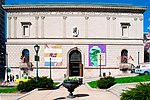Grace and St. Peter's Church
19th-century Episcopal church buildingsAnglo-Catholic church buildings in the United StatesBuildings and structures in BaltimoreChristian organizations established in 1912Churches in Baltimore ... and 4 more
Episcopal church building in BaltimoreGothic Revival church buildings in MarylandReligious organizations established in 1803Religious organizations established in 1850

Grace & St. Peter's Church is an Anglo-Catholic Episcopal parish in the city of Baltimore, in the Episcopal Diocese of Maryland. The congregation is the product of the 1912 amalgamation of two earlier parishes, St. Peter's Church (founded in 1803) and Grace Church (founded in 1850). Its building, constructed in Brownstone, is an elaborate example of English Gothic Revival architecture dating from 1852. Today, Grace & St. Peter's is distinguished by its Anglo-Catholic liturgy and professional choir. From 1940 to 2020, it was also home to the Wilkes School at Grace & St. Peter's, an Episcopal day school which closed in the midst of the COVID-19 pandemic.
Excerpt from the Wikipedia article Grace and St. Peter's Church (License: CC BY-SA 3.0, Authors, Images).Grace and St. Peter's Church
Park Avenue, Baltimore
Geographical coordinates (GPS) Address Nearby Places Show on map
Geographical coordinates (GPS)
| Latitude | Longitude |
|---|---|
| N 39.297777777778 ° | E -76.618055555556 ° |
Address
Grace and Saint Peters School
Park Avenue 709
21201 Baltimore
Maryland, United States
Open on Google Maps








